Bottles fly on new aseptic line
HP Hood is one of the largest and most progressive dairy companies in the world. It em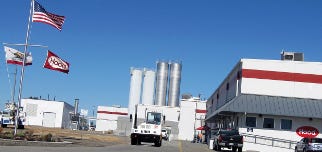
rrrrrHood.jpg
ploys approximately 3,000 people and owns and operates 16 manufacturing facilities with annual sales of approximately $2 billion. Hood has been committed to ultra-high-temperature (UHT) processing for more than 20 years and, in 2004, it moved to the ultimate level of shelf life when it installed the first aseptic low-acid rotary filler in the dairy industry at its state-of-the-art plant in Winchester, VA. That filler became the first FDA-accepted rotary filler for low-acid beverages when it was validated in 2005. Manufactured by Shibuya Kogyo Corp. (Shibuya Hoppmann Corp. in the U.S.), the 81-head filler runs 600 bottles/min.
Hood has installed its second Shubuya aseptic filler in a new line at its pla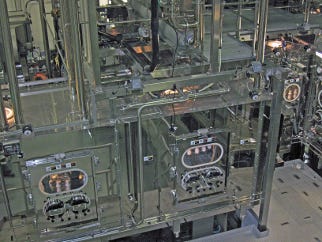
rrrrShibuya1.jpg
nt in Sacramento, CA, last July, and it began full operation earlier this year. There are currently only three Shibuya aseptic machines in the U.S., and Hood has two of them. To accommodate the new aseptic line, the footprint of the plant was increased to 130,000 sq ft.Director of operations Mike Hardy says, "The Shibuya filler at Winchester worked out very well and Shibuya is an excellent company to work with and provides great support. They had their engineers and electricians from Japan here during installation and startup, and they were also here during our first annual overhaul this summer."
The Shibuya enclosure is 80 ft long and 25 ft high with the aseptic sterilizing system on top of the enclosure, and bottles whizzing past the windows spaced along the enclosure at 600/min. It almost looks like a submarine at first glance. Adding to its impressive size is the fact that the entire enclosure is set high enough above the floor to provide easy access for maintenance.
Bottles handled by clamps
During PD's visit to the Sacramento plant, the aseptic line was running a nutritional product for a major food company. The filler is equipped with a fully automated CIP/SIP system that cleans and sterilizes the product lines and enclosure before each operating cycle. The system can maintain an aseptic environment inside the aseptic chambers for up to 156 consecutive hours. During this time, access is provided through glove boxes, and the entire system must be resterilized if sterility is broken.
To start the filling operation, 8-oz HDPE b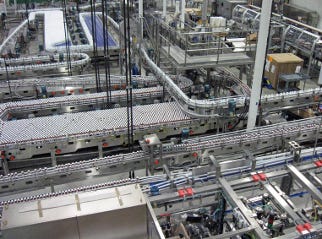
rrrrconveyros2.jpg
ottles are metered into the enclosure on an air conveyor and are picked up on the first starwheel by clamps that grasp the bottle at the neck. Neck gripping allows for the filler to accommodate different sized bottles with minimal changeover required. The bottles are held by neck grippers throughout the sterilizing/rinsing/filling/capping operations, all of which take place on rotating turrets. The bottles pass through three starwheels before entering the sterilizer turret, and a starwheel transfers the bottles from each subsequent turret to the next. In each transfer, bottles are transferred from one set of neck grippers to another.
Vaporized hydrogen peroxide is sprayed into the bottles in the first turret, after which they transfer into the air rinsing turret to assist in sterilization and begin removing excessive hydrogen peroxide. The bottles then travel into the rinsing turret, where they are inverted and sterile water is sprayed up into the bottle to remove any remaining residual peroxide solution. Next, the bottles are inverted to an upright position and a brief air blow is performed to help remove residual water.
The bottles then are transferred to the net-weight filler. Product is supplied from a holding tank that is located on top of the filler enclosure and travels down through the 81 fill nozzles and into the bottles. Each empty bottle is tared once it is in the filling station, after which the valve on that nozzle opens and begins filling. When the correct weight of product has entered the bottle, the nozzle closes. The weight-control computer automatically corrects for the effects of the centrifugal forces of the filler rotation and, in combination with a sophisticated compensation routine, achieves a fill accuracy of plus/minus 0.5g and 100 percent feedback on each filling station.
The bottle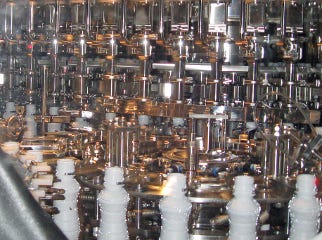
rrrrrShibuya3.jpg
s then transfer to the 18-head capping turret where the servo capper applies screw caps to the containers. Constant torque is achieved by a computer-controlled servo motor mounted on each capping head. For each bottle, capping starts in a low-torque mode, speeds up and then applies the final torque at the end.
The servo drives on the capping heads monitor operating parameters, making it easy to detect misaligned caps, abnormal torque and other errors, and provide 100 percent feedback on each capping head.
Caps go through a sorter mounted above the enclosure and travel through a similar hydrogen peroxide sterilizing procedure as the bottles. Bottles are transferred onto a tabletop conveyor after leaving the enclosure.
The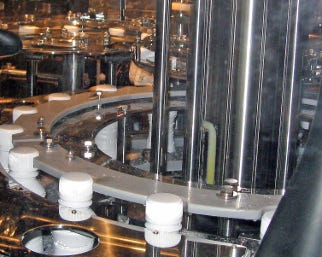
rrrrshibuya4.jpg
entire Shibuya operation can be monitored by a centrally located SCADA computer and is operated through a touchscreen HMI. Hood runs a number of different bottles on the aseptic line and each requires different sterilizing conditions, depending on shape and size. Torque settings are also different for different bottles. Once these operating parameters are set for a container, they can be recalled automatically on the touchscreen.
Presureless conveying
The aseptic line runs bulk containers that are received on pallets. They are depalletized by a Model 400G2 bulk depalletizer from FleetwoodGoldcoWyard. Pallets of plastic bottles, which are supplied by Graham Packaging, are placed on the first-floor infeed conveyor and are raised to the mezzanine depalletizing level, where they are swept onto the discharge conveyor one layer at a time.
The sweep mechanism, with its associated grippers and pushers, was specially designed to accommodate the six bottles that Hood runs on this line. Changeover parts are not required as the one design will effectively transfer each layer of bottles from the hoist to the depalletizer bed.
The pallet rises after each layer has been removed and vacuum cups automatically remove the pads on top of each layer of bottles. A sensor detects the height of each layer and stops the rise of the table at the proper level. When all of the bottles have been removed from a pallet, it is automatically removed and placed into a hopper.
As the bottle leave the depalleti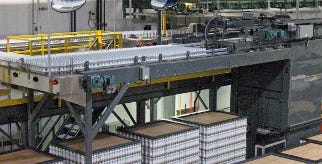
rrrrdepalletizer.jpg
er, they are single-filed by a pressureless combiner system supplied by Conveyor & Automation Technologies Inc. (C&AT). C&AT supplied all of the bottle and case conveyors for the aseptic line, with the exception of the air conveyor that carries the bottles down from the mezzanine to the Shibuya unit. C&AT, which was the systems integrator for the entire aseptic packaging operation, developed the layout, manufactured all of the stainless steel tabletop conveyors, provided the floor plan and the line controls for the entire aseptic operation, coordinated the project with the other equipment suppliers and installed the conveyors and equipment. It also purchased, installed and took integration responsibility for the depalletizer.
Hardy says, "Conveyor & Automation Technologies has worked at the Winchester plant and here in Sacramento in the past, and I can't say enough good things about them. They are very customer focused, and they have always done an outstanding job for us. They integrated the entire new aseptic line here at Sacramento and supplied all of the conveyors and accumulators."
Because the bottles are so light and unstable, single filing them was a challenging process. Gus Sarikas, C&AT's vp of sales, says, "These bottles are very lightweight and tip easily. The best way to handle them is with our pressureless technology." C&AT's pressureless conveyor system consists of a series of side-by-side flat conveyor chains with each change gradually increasing its speed as they approach the discharge. Ultimately this 35-ft-long system separates the bottles, with no pressure, into a single file.
rrrrair2_0898.JPG
The bottles are transferred into an
rrrrair1_0895.JPG
air conveyor from Lanfranchi North America that uses filtered air flowing through a chamber to push them along rails down to the filler. The system incorporates a series of sensors and gates that regulate the bottle movement. It is equipped with an automatic changeover system for different size and shape bottles that can be easily and quickly selected through the program pre-set on the HMI.
Bottles transfer from the air conveyor to a tabletop chain conveyor supplied by C&AT at the inlet of the filler enclosure. This conveyor, which transports the bottles into the enclosure, rises and lowers to deliver the different height containers to the bottle clamps on the filler.
After leaving the filler enclosure, the bottles pass through a leak detector from Teledyne Taptone that uses parallel belts to squeeze the bottles. An arm sweeps leakers onto a reject conveyor. QC inspectors also use this reject system to divert bottles for inspection at regular intervals by pushing a button that diverts a predetermined number of bottles onto the reject conveyor.
The system identifies which fill nozzles the diverted bottles came from to expedite any corrective measures that are required.
Conveyors and
accumulation tables
The bottles then travel through a sinuous and extensive series of conveyors and accumulation tables as they are transported through the downstream equipment. The room for the new aseptic line is about 100 x 150 ft, and the Shibuya enclosure and associated aseptic tanks and equipment takes up about 20 percent of that.
As mentioned previously, the filler is elevated and the conveyor leaving the filler is also elevated so that it travels over some of the conveyors feeding downstream equipment. All conveyors have variable-frequency drives and high/low speed sensors to control flow.
This conveyor descends to deliver filled bottles to the first and largest accumulation table in the line. This is between the filler and the labeler, and consists of two 4-ft wide sections. The bottles enter a 24 ft long section, make a 180-deg turn and go onto a 30 ft long section.
This provides about 10 minutes of accumulation. Sarikas says, "The filler runs 600 bottles/min, but we designed all of the conveyors and accumulation for 900 bottles/min so we could empty the line out after a shut down. The primary requirement was that the filler had to keep running, no matter what, so we had to provide enough accumulation to empty the filler. Also, Hood required first in/first out accumulation, as provided by C&AT."
The accumulation conveyors are built in 4-ft long sections. Each 4-ft wide x 4-ft long section has its own variable-frequency drive and a sensor that turns it on and off. Sarikas says, "We don't want any pressure on the bottles. We want to be able to easily lift any bottle out of the mass." The accumulators have micro-pitched chains with 5/16-in. pitch at the nose to prevent bottle-tipping during transfers.
Bottles leaving the accumulation tables are single filed using the pressureless system described previously. Hood has installed a two-head shrink-sleeve labeler from Sleever Intl., and each head operates as a standalone unit. A gate diverts the bottles into two lanes as they approach the sleever. The control system will shut one lane down if one of the labeler heads is not working.
Feed screws on each lane meter the bottles to maintain the proper spacing as the bottles enter the sleever. Two rolls of sleeve labels for each lane are mounted on horizontal shafts in a twin-unwind system configuration. When the roll in use runs out of material, the standby roll is automatically spliced to the roll in use without stopping or slowing the machine.
The labels are pulled from the roll and travel over dancer rolls for tension and tracking control, and then over a roller at the top of the machine and down into the application section. Rollers pull the film over a mandrel where it opens into a cylindrical shape, and it is then cut into individual sleeves by blades that travel around the mandrel.
A registration system advances or retards the film travel so the cut takes place in the proper location. A sensor detects the presence of a bottle on the conveyor and triggers two rollers that fire the sleeve down onto the bottle as it passes below. A series of small rotating vertical brushes pushes the sleeve down against the label to ensure that it will shrink all the way to the bottom of the bottle.
The bottles then enter a steam tunnel where multiple nozzles are individually adjustable for optimum shrink results. The labeler and shrink tunnel are computer-controlled, and all of the operating settings for each bottle can be adjusted by the operator and will be retained in memory for easy recall.
Sleever Intl. and others supply the shrink-sleeve labels used on the bottles. The labels, which are made out of OPS material that is specifically designed for the steam technology, feature a perforated section beneath the cap for easy tear-off.
Bottles leaving the two labeling heads are combined and conveyed to the second accumulation table in the system. This consists of a 25-ft long, 4-ft wide section, a 180-deg turn and a 25-ft long, 2-ft wide section, which provides an accumulation of about five minutes.
Cartoning, tray loading
and shrink wrapping
The bottles leaving the accumulation table are single filed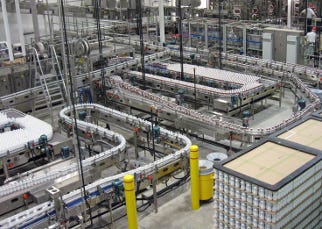
rrrrConveyors1.jpg
and travel to a Model 603 overwrapper from Aries Packaging or to a Model 552 combined shrink wrapper/wraparound case packer from Baumer. Both Aries and Baumer are represented and serviced in North America by Geosaf.
During PD's visit, the line was running 4-pack cartons, so the bottles were conveyed to the Aries overwrapping machine. If the line was running individual bottles, they would bypass the Aries and proceed directly to the Baumer packer. The Aries is a high-speed, multi-format fully servo-driven machine capable of running 180 packs/min in 4-pack cartons.
Pack configuration can be with gussets, neck through or full wraparound in 4-, 6- and 8-pack formats with different bottle sizes. Format changeover is completely automated and can be achieved through the HMI in less than 20 minutes for the longest changeover (bottle size and pack count).
The bottles are fed into two lanes entering the machine and are separated in collations of four bottles through starwheels and side grippers. As the bottles are transferred to the wrapping zone, paperboard carton blanks are de-stacked from an overhead magazine by vacuum cups mounted on articulated arms on a rotary wheel and are placed over the tops of the four-bottle groupings.
The bottles are conveyed between top and bottom belts through the folding unit that folds the cartons over them while forming the gussets. Hot-melt glue is sprayed onto the bottom flap of the cartons prior to entering the pressing zone. The flaps are ploughed beneath the bottles as the packs travel.
The cartons the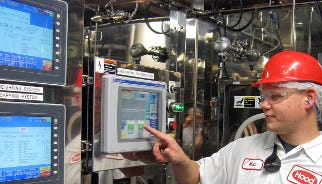
rrrrMatt.jpg
n travel through an integrated Aries 850 servo-driven one-to-three continuous lane divider that feeds the Baumer packer. The Baumer is a high-speed combined shrink wrapper and case/tray packer that can produce tray-and-film and wraparound cases of carton packs or single bottles at a speed of 900 bottles/min. The machine is equipped with a fully automated dual film unwinding unit that attaches the film from one reel to the other without stopping production. Sideways introduction of pre-folded blanks combined with a compact, high-efficiency shrink tunnel allow for a short-in-length machine.
The 4-pack cartons, separated into three lanes, are continuously collated into groupings of six cartons as they enter the tray packer. When the line is running bulk packs, the bottles enter the Baumer in mass flow and are divided into four to six channels, depending on the format. Bottles are then continuously separated into the required groupings using the same collation system as for the cartons.
Vacuum cups on a rotating wheel pick up flat tray blanks from a magazine on the side of the Baumer packer and place them on a vacuum transfer conveyor that delivers them pre-folded, sideways into the machine.
The cartons are simultaneously transferred with push bars onto the blank. Mechanical arms fold up and around the front and the back flaps of the tray, which is then pushed through guides that fold up the side flaps as the hot melt glue is applied.
The loaded tray then passes into the wrapping section, where a roll of film is mounted beneath the conveyor. The set length of film is pulled from the roll, cut and placed on a transfer belt that places it in line with the tray as it enters the wrapping section. An arm pushes the film under the front of the tray after which an overhead arm moves the film over the top of the tray and tucks it under the back end. The tray then enters the heating zone, where the film is sealed.
The trays exit the wrapper and travel past an inspection system that checks to see that all of the flaps are glued. The cases then pass an inkjet printer from Diagraph, an ITW Co. that applies a lot code and production date to the tray.
The trays travel up an inclined conveyor to an overhead roller conveyor that transports them to the palletizer. C&AT supplied this entire case conveying system, in which the conveyor itself provides accumulation, rather than having separate accumulating units.
The conveyor incorporates C&AT's zone system in which the conveyor is separated into 2-ft long powered roller sections, each of which is driven separately. The rollers are driven by belts that run beneath the rollers and turn them by friction. When a sensor detects that cases are backing up on the conveyor, the drive belts for that section are lowered from contact with the rollers, which then do not turn.
A unique element of this system is that th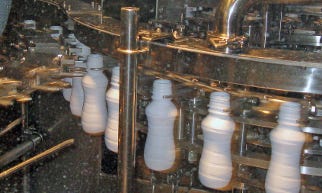
rrrrShibuya2.jpg
e drive belt actually runs beneath a long length of roller conveyor and is pushed up against the roller conveyor in 2-ft sections. Thus, one motor can drive up to 50 ft of roller conveyor.Cases are palletized by an Alvey Model 910 unit from Intelligrated Inc.
Integrated controls
C&AT was the systems integrator for the entire aseptic packaging operation. They provided the floor plan and complete line integration for the entire aseptic operation, coordinated the project with the other equipment suppliers and installed the conveyors and equipment. All of the conveyors and equipment in the line, except for the Shibuya filler, are monitored and controlled from the HMI in the control room. The Shibuya has its own dedicated HMI.
Conveyors are equipped with variable-frequency drives from SEW-Eurodrive Inc. and sensors throughout the line that can switch from low to high speed to regulate bottle travel and even shut off sections if necessary. Each machine is wired into the Ethernet network, and when the operator turns the line on, the computer sets all of the conveyors into Auto mode. Each machine is started individually, and all of the conveyors are looking for the signals from individual machines.
Sarikas says, "We placed sensors where we could modulate the speed or stop a motor to minimize bottle pressure. This was a collaborative endeavor so another challenge was to make sure that we could meet the requirement of each machine supplier. Each individual machine has its own start procedure, but they are all integrated into the central system."
Conveyor & Automation Technologies Inc. 410-828-1904. www.conveyor-automation.com
Diagraph, an ITW Co., 800-722-1125. www.diagraph.com
FleetwoodGoldcoWyard, 630-759-6800. www.fgwa.com
Geosaf, 514-331-4147. www.geosaf.com Montreal, Quebec
Graham Packaging Company, L.P., 717-849-8500. www.grahampackaging.com
Lanfranchie, 813-901-5333. www.lanfranchigroup.com
Intelligrated Inc., 877-315-3400. www.intelligrated.com
Shibuya Hoppmann Corp., 800.368.3582. www.shibuyahoppmann.com
Sleever International, 905-565-0952. www.sleever.com
SEW-Eurodrive Inc., 864-439-8792. www.seweurodrive.com
Taptone Div. of Benthos, Inc., 508-563-1000. www.taptone.com
About the Author(s)
You May Also Like


